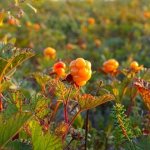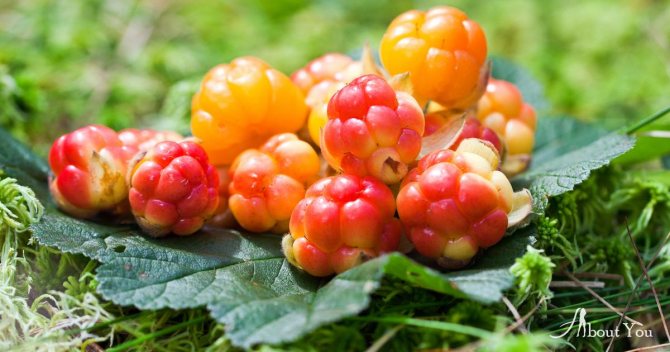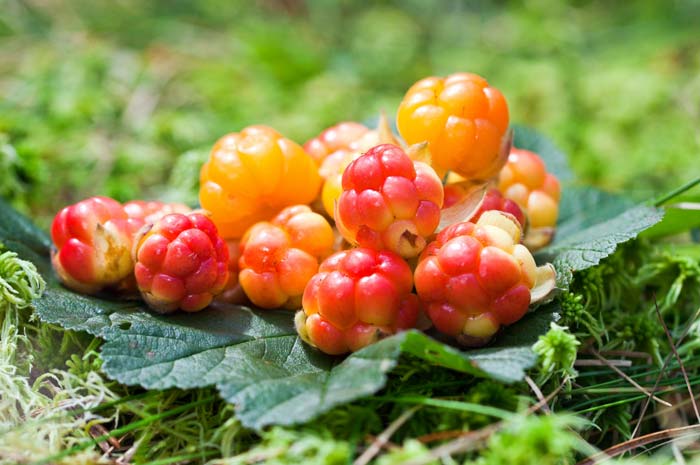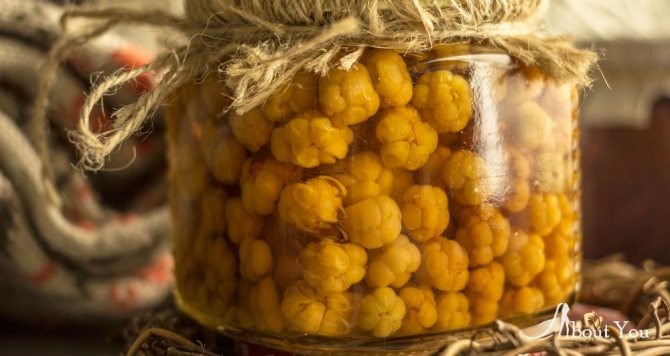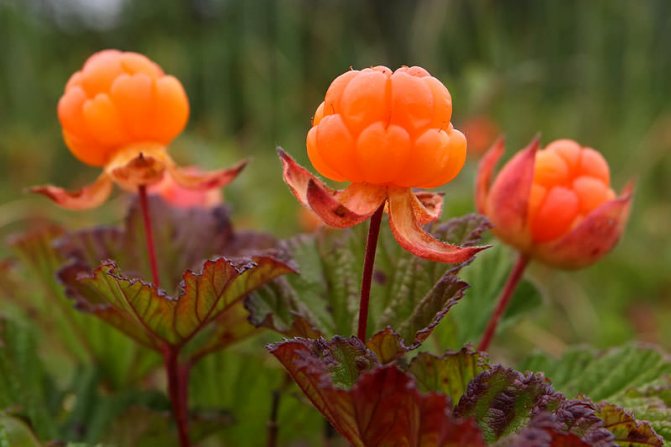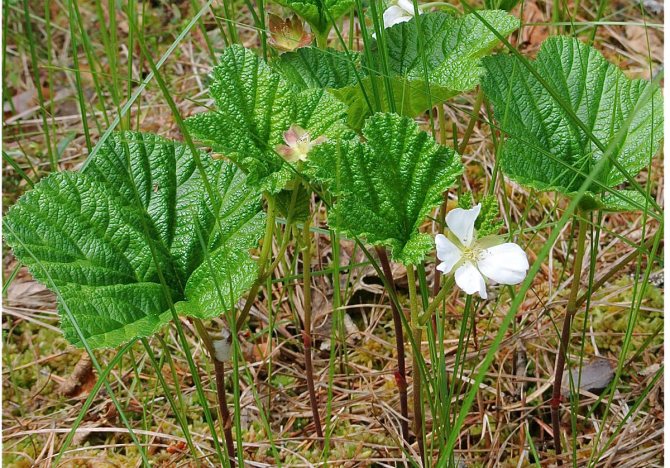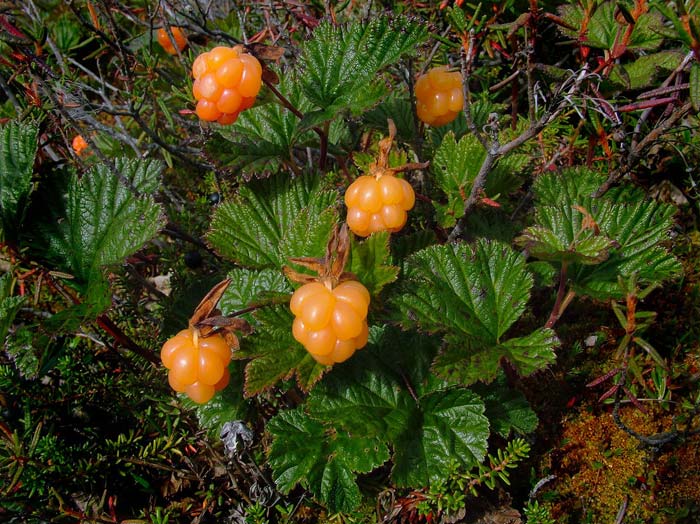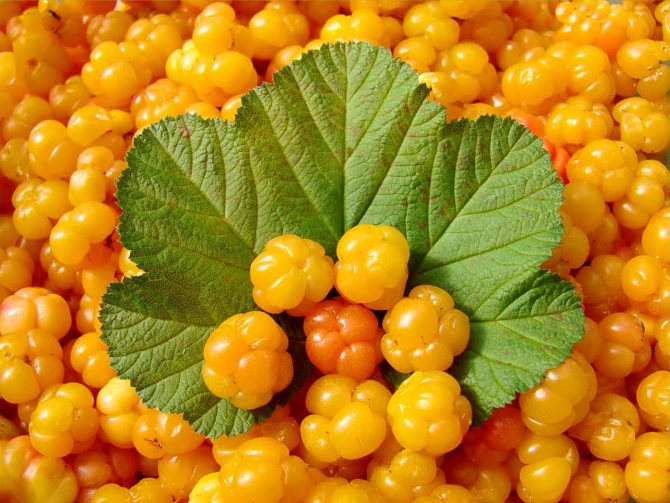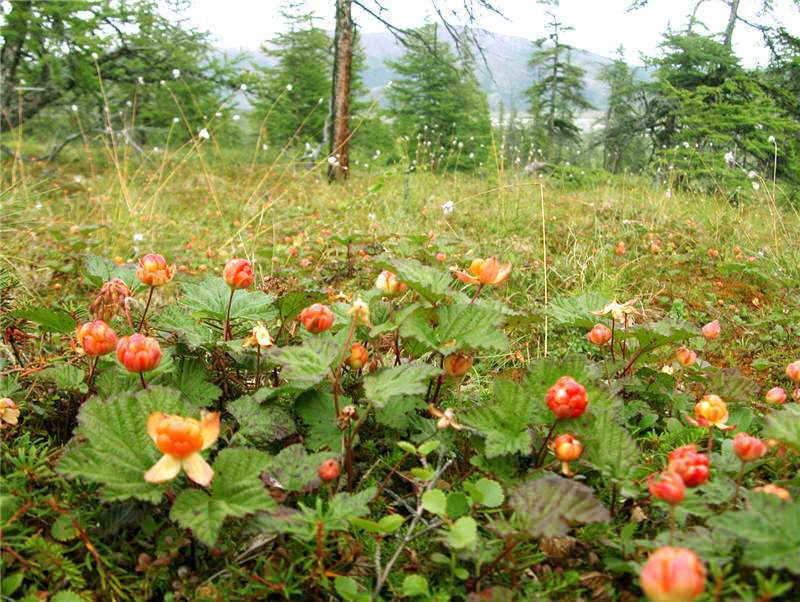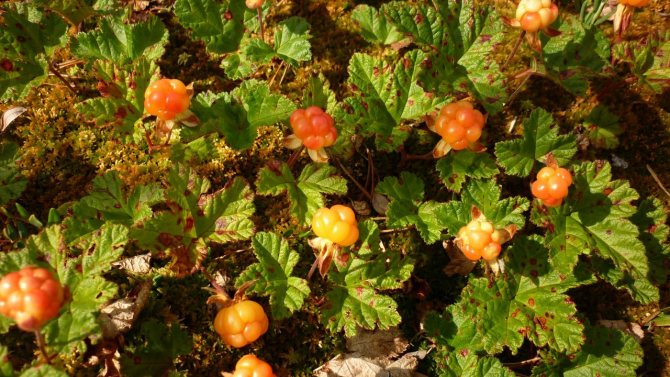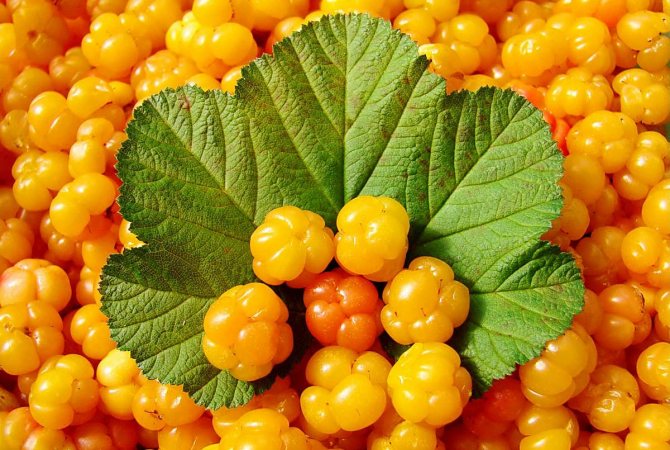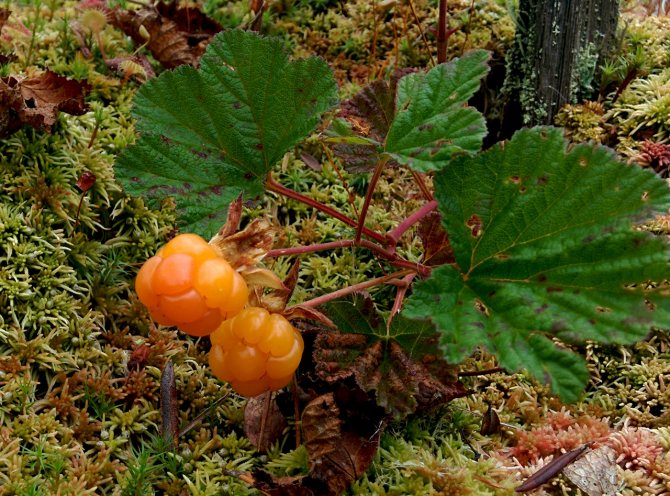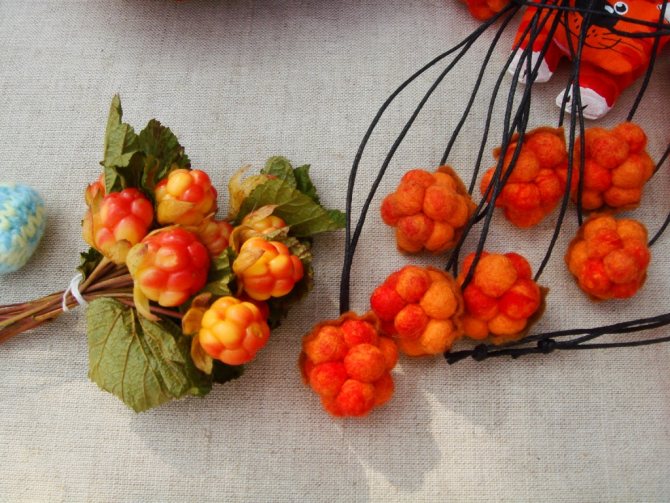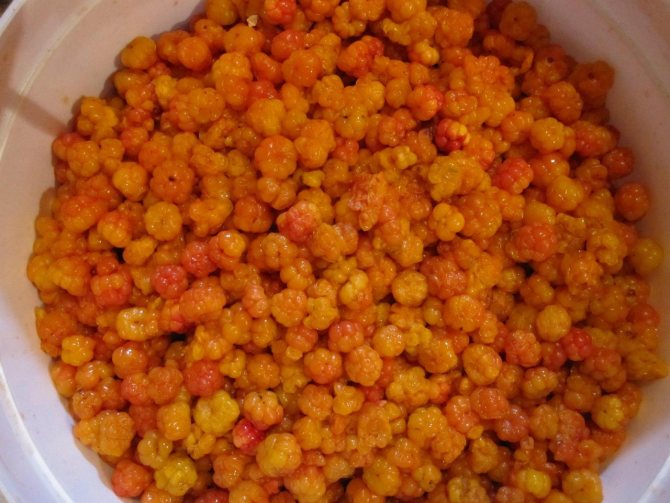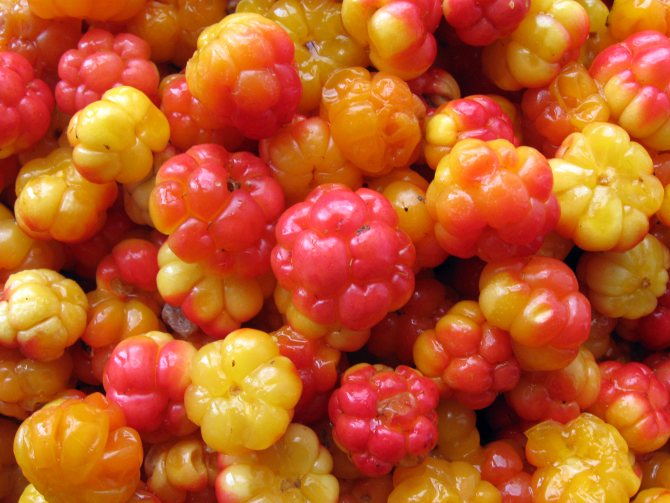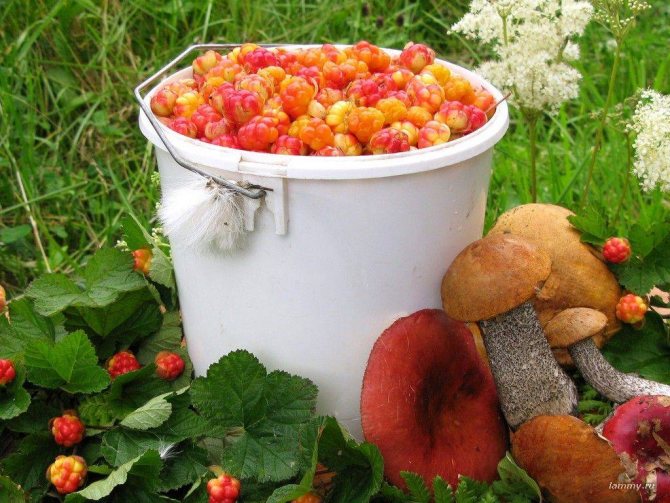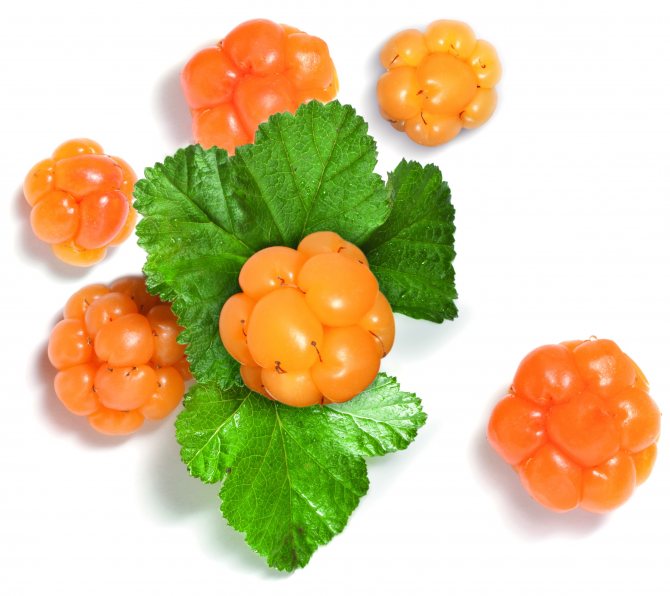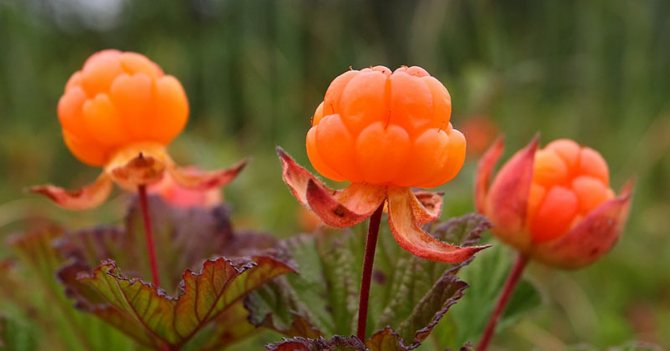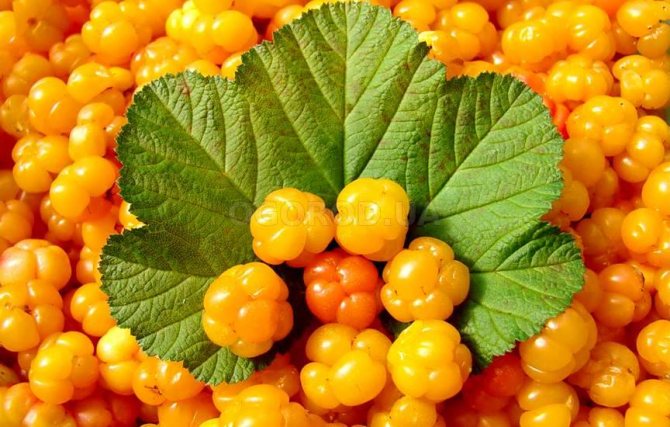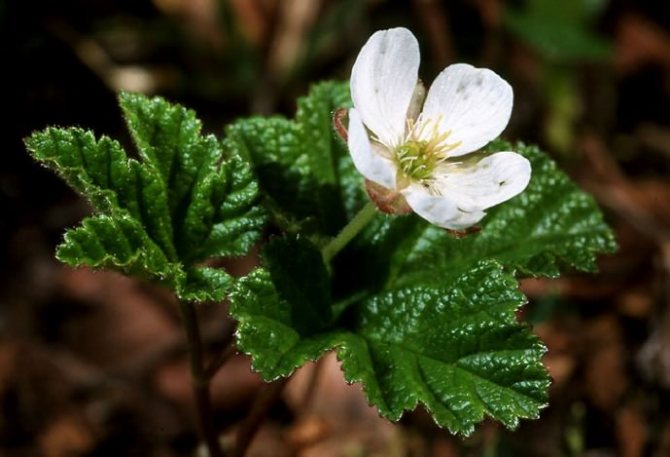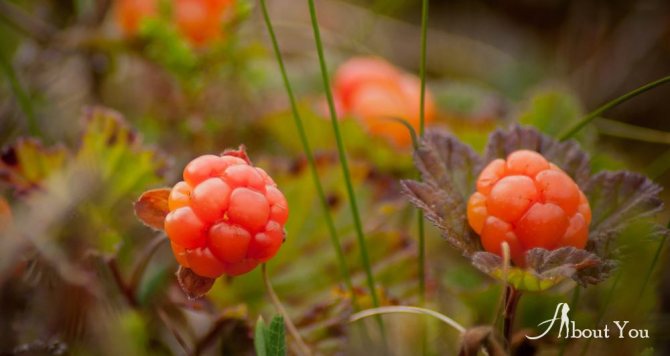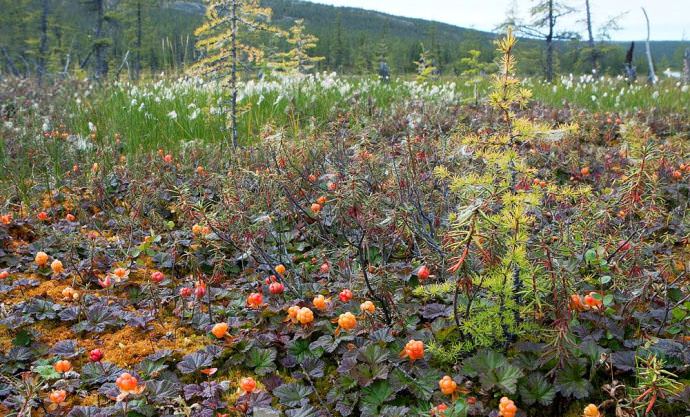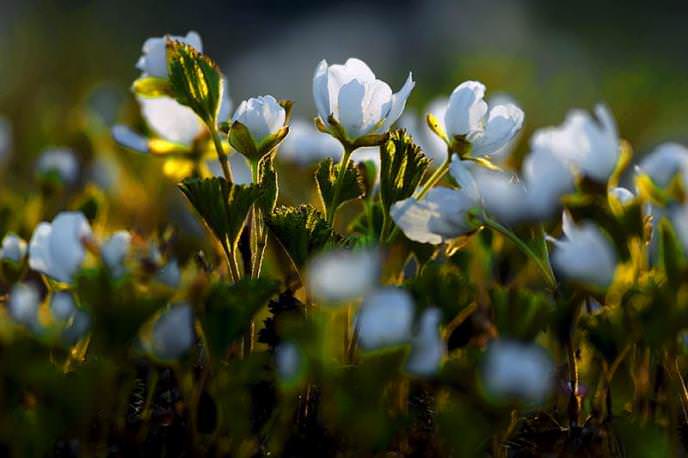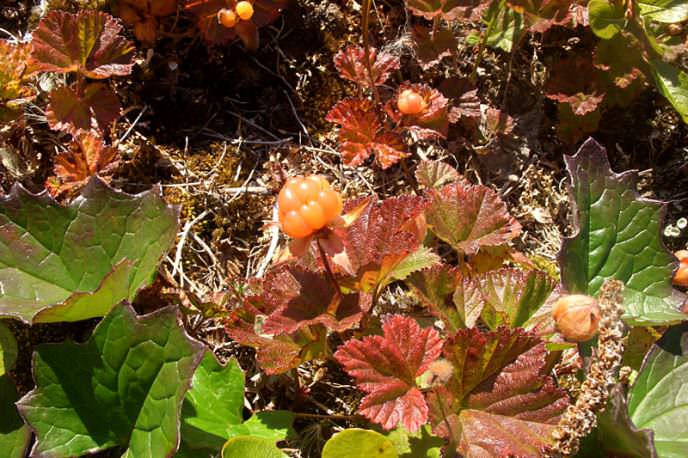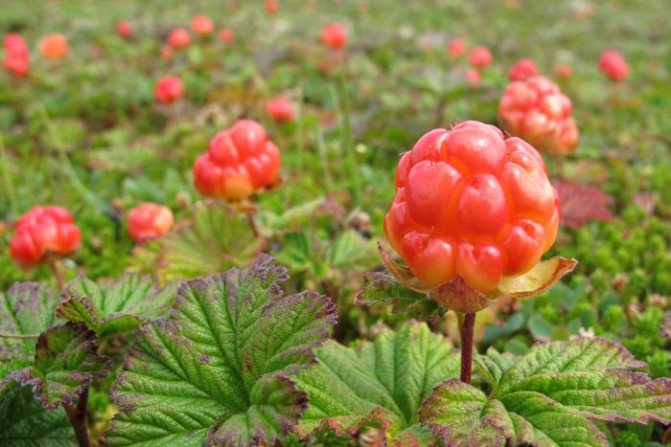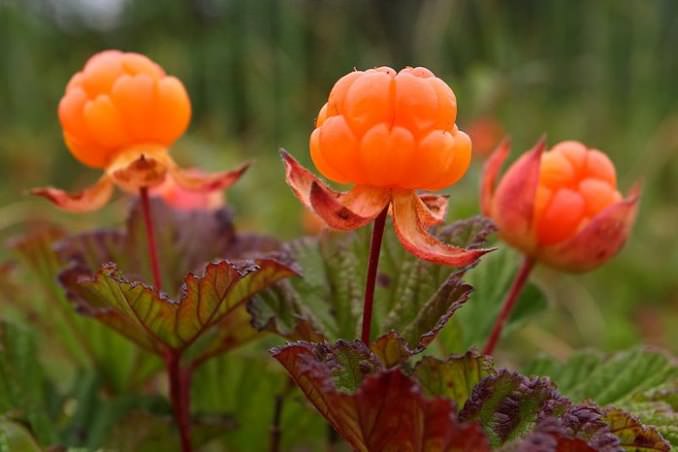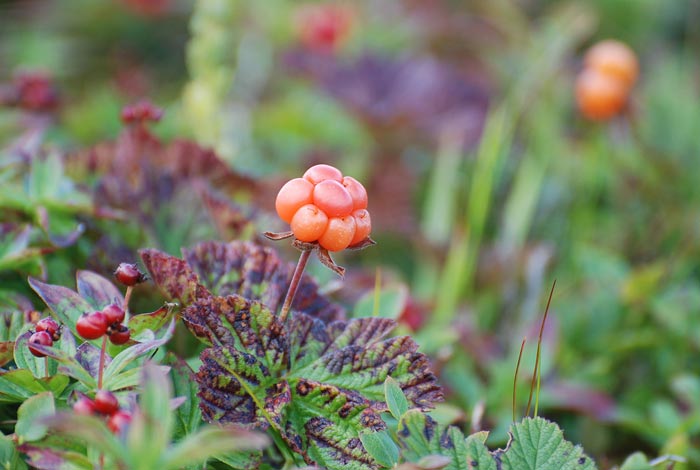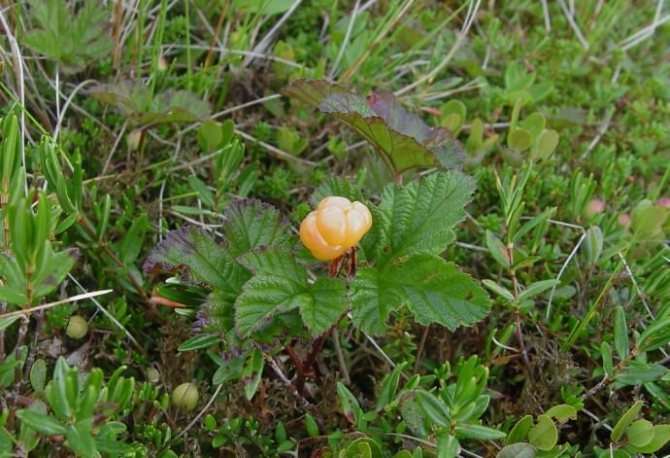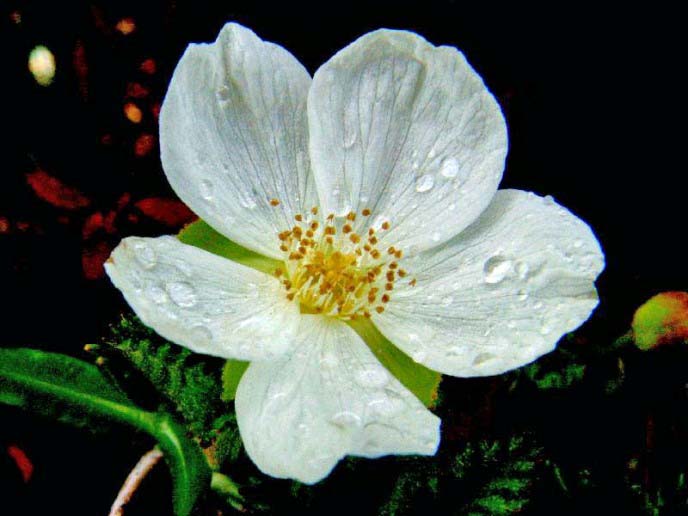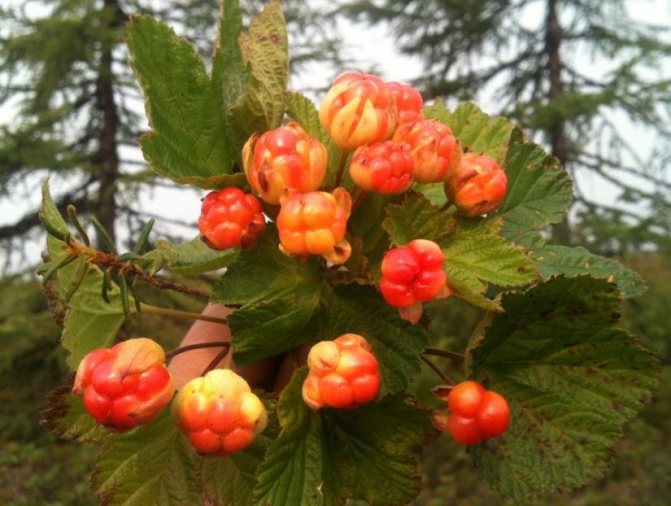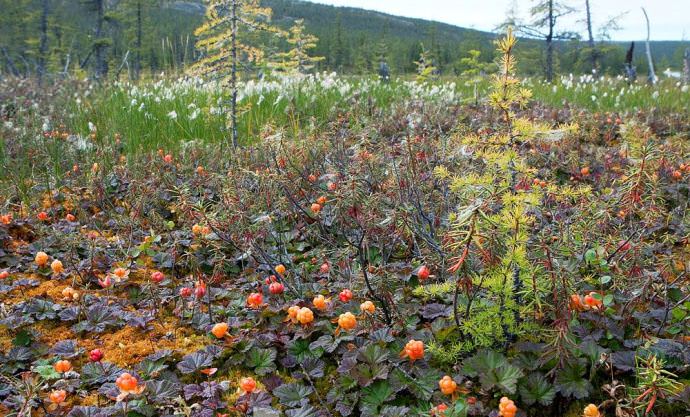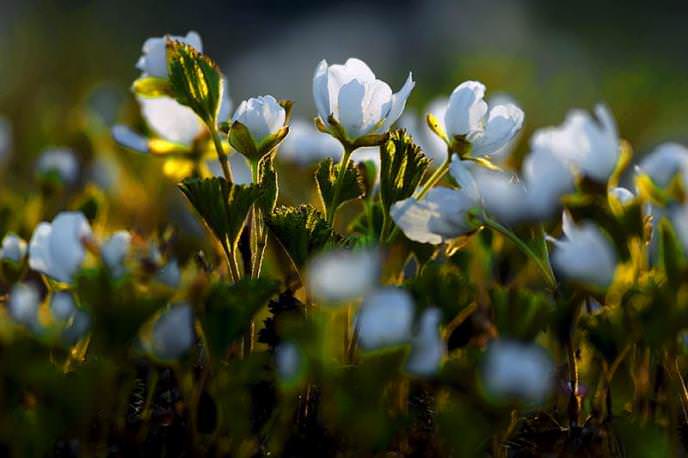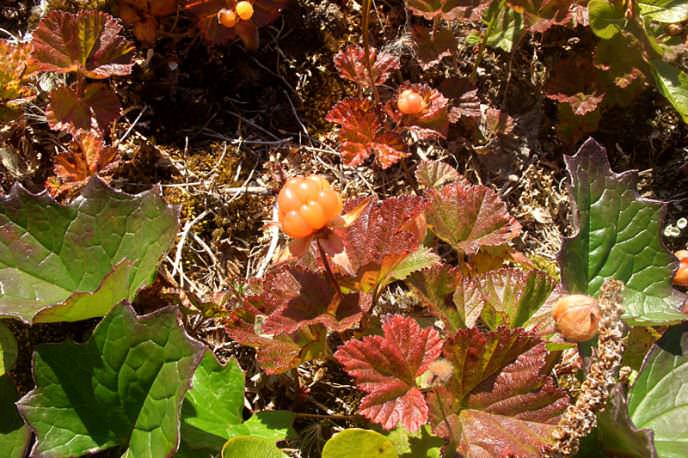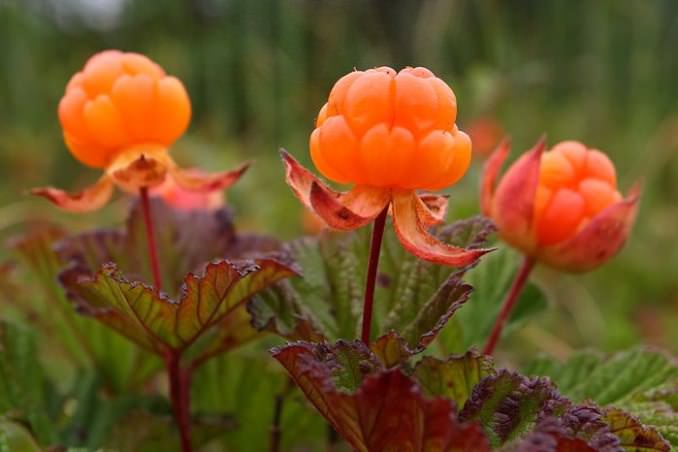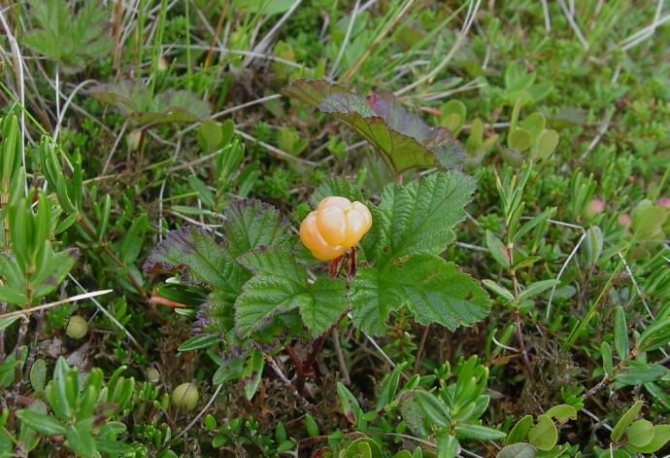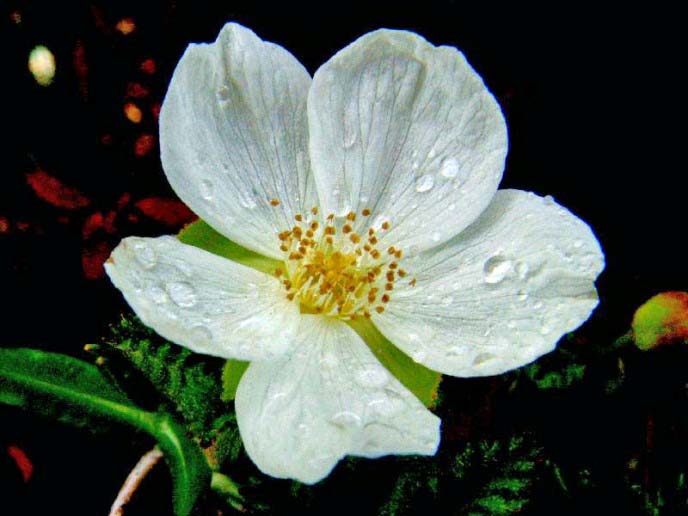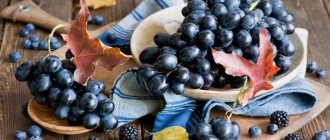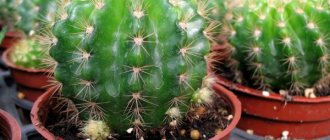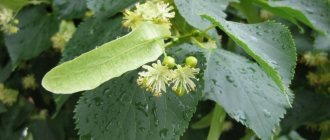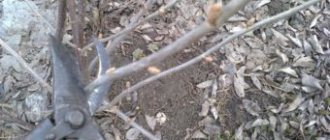Category: Fruit and berry plants
Cloudberry (lat.Rubus chamaemorus) - a species of herbaceous perennials of the genus Rubus of the Pink family with edible fruits. The scientific name of the species is derived from the ancient Greek "on the ground" and the Latin "mulberry" - "earthen mulberry". Both the plant and its fruits are called cloudberries. This culture is also known as swamp fire, swamp guard, northern orange, arctic raspberry, moss currant, gloshina and royal berry. Where does cloudberry grow? Its range extends throughout the Northern Hemisphere. Cloudberries can be found in peat bogs, in moss bushes, it grows in the tundra, in the northern forest belt, in central Russia, in Siberia, in the Far East and in Belarus.
In culture, cloudberries are grown for the production of jam, juice, compotes, jam and other preparations, which are usually made for the winter. The berry is also used for medicinal purposes. The cloudberry plant is grown commercially in the United States and Scandinavia, and in Finland, where this particular plant is depicted on a 2 euro coin, an experiment is underway on greenhouse cultivation of the crop. Such interest in cloudberries is caused not only by the fact that the berry is rich in biologically active substances, but also by the fact that it has healing properties for the treatment of a number of diseases and is used in both folk and official medicine.
Description of the plant
Marsh shrub, creeping (you can see how it looks in the photo). The petals are white. Fruit ripening occurs from July to August. Flowering is observed in May-June. In appearance, the berry is similar to raspberries, but its aroma and color are different.
Where does cloudberry grow? In the north, in the middle zone of the Russian Federation, in the Far East, in Belarus. Moss, lingonberry, and wild rosemary can often be found next to the shrub. Shrubs are often found in peat bogs, in swampy forests, in moss, shrub tundra.
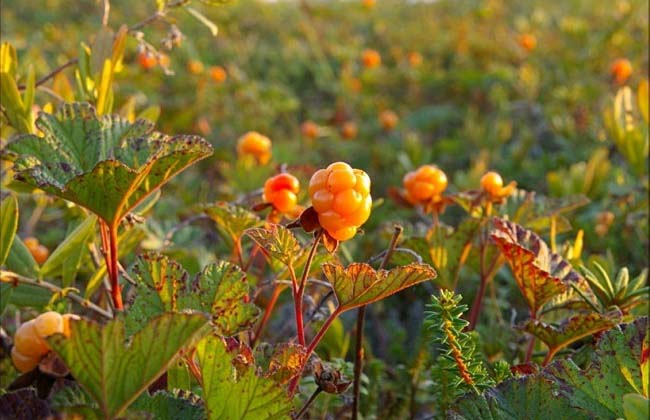
The plant belongs to the genus Rubus, the Pink family. Its height is 30 centimeters. Rhizomes are creeping, stems are thin.
Northern peoples respect cloudberries and value their properties. In ancient times, the berry was called a marsh guard, now it is called moss currant, arctic raspberry and northern orange.
In Kievan Rus, it was considered a delicacy for tsars - it was served both wet and fresh. Delicious kvass can be made from the fruit. In Scandinavia, the plant is still of great value, as its medicinal properties help to cure many diseases. Since ancient times, the fruits have been used for scurvy, and the leaves have been used for scabies and for treating wounds.
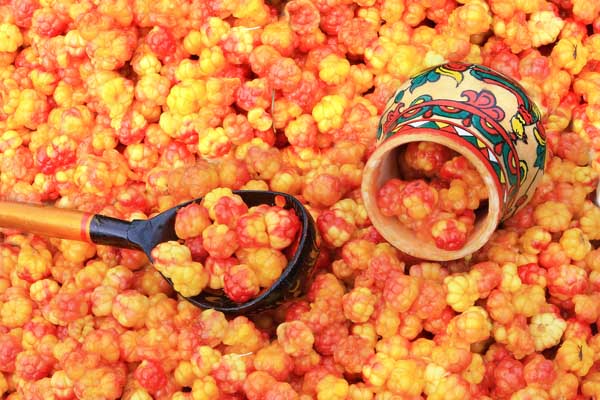

Proven recipes
Cloudberry is a favorite berry of all northerners. Compotes, jelly, cloudberry jam, whether fresh, dried or soaked, are tasty and useful to almost everyone - both adults and children. According to the northern tradition, the hostesses prepare "hitchhikers", pies and cheesecakes with cloudberries for farewell and meetings.
Although cloudberries have always grown only in the North, they love this berry and its products everywhere. Cloudberries can be eaten in all forms. Jams, juices, sweet sauces for ice cream and desserts, fillings for baking are very tasty from it. Steamed and soaked cloudberries have an amazing taste. It is rubbed with cranberries and lingonberries, sauces and jellies are made from berries.Cloudberry sauces are a great addition to game and meat dishes. In Finland, tourists are often offered national dishes - fresh cloudberries on heated cheese or berry jelly with milk or cream.
Cloudberry kvass
- water - 4 l - cloudberries - 800g - sugar - 200g - yeast - 25g - citric acid - 3g.
Sorted and washed cloudberries, mash with a pestle, pour hot water, bring to a boil, leave for 2-3 hours, strain, add diluted yeast, sugar, citric acid and leave to ferment.
Cloudberry jelly
- cloudberries (ripe) - 1 kg - sugar - 1 kg.
Pass ripe cloudberries (soft, already yellow) through a juicer or, if there is none, rub through a sieve. (You don't need to throw out the pomace, you can cook a delicious fruit drink from them by boiling them with a small amount of sugar.) Mix the resulting mass thoroughly with sugar, pour into jars.
Cloudberry Kissel
- cloudberries - 100g - sugar - 100g - starch - 45g - water - 1l.
Crush the berries, add hot water and bring to a boil. Keep on low heat for 10 minutes and strain through a sieve. Add diluted starch, sugar to the resulting broth and bring to a boil. Cool and pour into glasses or vases.
Sugar-free cloudberry juice
Blanch the washed berries in hot water and pass through a juicer. Pasteurize the juice, pour it into boiled bottles, close it with corks, fill it with resin or wax and store in a cool place.
Cloudberry juice with sugar
- cloudberries - sugar - 500g (per liter of juice)
Scald the washed berries with boiling water, rub through a sieve, add sugar at the rate of 500 g per 1 liter of juice. For long-term storage, the juice must be pasteurized.
Cloudberry compote
- cloudberries - 250g - sugar - 100g - citric acid - to taste - water - 1l.
Arrange the prepared berries in glasses, pour hot sugar syrup and let it brew for 40-50 minutes.
Cloudberry jam
- cloudberries - 1 kg - sugar -1 kg - water
Rinse the cloudberries in a bowl, put them in a sieve, then under running cold water, turning the sieve, rinse all the berries and let the water drain. Pour water into the sugar, stir, put on fire, stirring, until the syrup boils; then add the berry and cook for 30 minutes. Then rub the berry through a hair sieve, put in a basin and cook for 10 minutes.
Cloudberry Jelly (2)
- cloudberries - 100g - sugar - 30g - gelatin - 5-6g - water - 1 glass.
Crush the berries with a pestle, add 1 glass of water, boil for 1-2 minutes, strain, add sugar and gelatin soaked for 10 minutes, bring to a boil, pour into molds and put in the cold. Before use, place the molds in warm water for 1 minute, put the jelly on a plate
Cloudberry and lingonberry jelly
- cloudberries - 100g - lingonberries - 100g - sugar - 60g - gelatin - 12g - water - 1 glass.
Crush the berries with a pestle, add 1 glass of water, boil for 1-2 minutes, strain, add sugar and gelatin soaked for 10 minutes, bring to a boil, pour into molds and put in the cold. Before use, place the molds in warm water for 1 minute, put the jelly on a plate
Cloudberry jam
- cloudberries - 1 kg - sugar - 1.2 kg.
Rub the berries through a sieve, mix with sugar and boil until the desired density.
Photo gallery
Landing rules
Cloudberry grows in swamps. But what if the site does not even remotely resemble it? The way out is as follows: just allocate a place on the site for growing berries and make it swamp by hand.
- The place where the berry will be located should be well lit.
- A trench is being dug, its depth should be half a meter.
- Then soil, polyethylene, again soil and again polyethylene are laid out in layers. The top layer should be soil mixed with peat or substrate removed directly from the cloudberry's natural habitat.
- Then you should water well that part of the site where the berry will grow. The moisture level has to be monitored every day.
- You should also pay attention to the acidity level. The indicator should be equal to 4.5 pH.
- Cloudberry in natural conditions has such a neighbor as mycorrhiza. The properties of the fungus are that it supplies nutrients to the roots of the plant. You can buy the drug with it at a flower shop.
Collection and procurement
It is currently a hard-to-find, rare berry. Not only does it grow in poorly accessible places, uncontrolled harvesting has led to the destruction of the once vast thickets of cloudberries.
The fruits do not ripen evenly, they are harvested in several stages. If picked early, it will be sour, tasteless berries. Late harvest is overripe berries that quickly deteriorate. The most suitable time for harvesting is the beginning of August. If the fruits are bright red shades and hardly come off, this is a sign of not ripeness and it is too early to pick such a berry. Ripe is considered to be yellow, soft fruits, which, when pressed, release juice. Collect in small containers so that the fruits do not lose their shape under their own weight.
How to care
- Cloudberries are used to acidic soil, so if you water them with water from a well, they can get chlorosis. To prevent disease, ground sulfur is introduced into the soil - 30 grams per 1 square meter.
- In order for the berry not to get sick, you can acidify the water for irrigation. Add 2 grams of acetic or citric acid to the bucket.
- Since the plant is small, the distance between the bushes should be 20 centimeters. In this case, the type of cloudberry must be taken into account.
- Pruning is carried out only sanitary - they get rid of dried and diseased branches.
- Top dressing is introduced in the spring. Mineral solutions and organic products are used as fertilizers. Manure can be used.
- Periodically, the soil should be loosened and weeds removed (especially in the first year).
- To protect the plant from pests and fungal diseases, it should be treated with a solution of Bordeaux liquid in the spring.
- Harvesting takes place after the fruits have acquired an amber hue (see photo).
- The pests of the bush are the same as those of raspberries, for example, the raspberry mite.
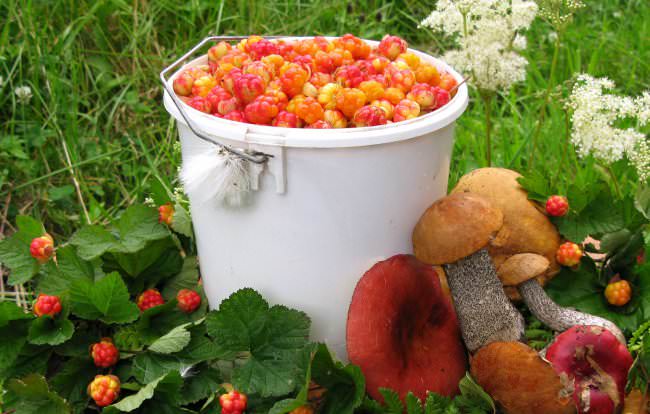

Harvest
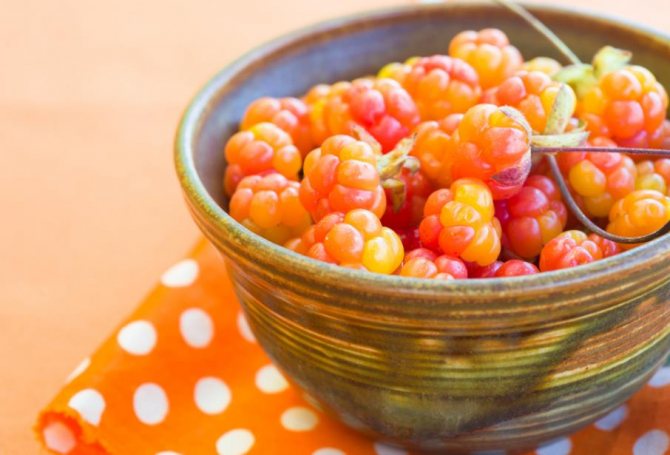

You shouldn't delay harvesting cloudberries - this berry will ripen quickly. They are cut off from the bush together with sepals, which are then dried and used for brewing in tea. The berries are usually harvested in July, when they are orange-red and slightly unripe. Fully ripe berries instantly turn into gruel. After the cloudberries have been harvested, you should immediately start processing them. If you plan to freeze the berries, make jam from them - they do this on the same day. Otherwise, they will acidify and become unusable for further use. It is worth paying attention to the fact that cloudberry shoots are annual. Those that bear fruit this year will die off, and new ones will appear in the spring. Therefore, after complete harvesting, you need to clean up the plantation - with the help of garden shears or pruning shears, cut off old shoots. If this is not done, the next year there may be difficulties with the germination of young shoots, therefore, loss of yield.
Reproduction
Cloudberries reproduce in a variety of ways.
- Just dig some bushes in the forest and transplant them onto your site. The selection should be made strictly - plants with the most juicy and tasty berries are taken (you can see how they look in the photo). The selected shrub is dug out with a clod of earth and immediately placed in a pot. You can also use a paper pot. Cloudberry is buried right with it in the ground at the site.
- Another option is cuttings. They are cut into 12 centimeters and placed in a nutrient substrate.From above, the cloudberries are covered with a film and watered abundantly.
Important! The moisture content of the soil should be at a high level at all times. In autumn, the matured cuttings are transplanted. But you can wait another season, so that the cloudberries are better prepared for transplanting.
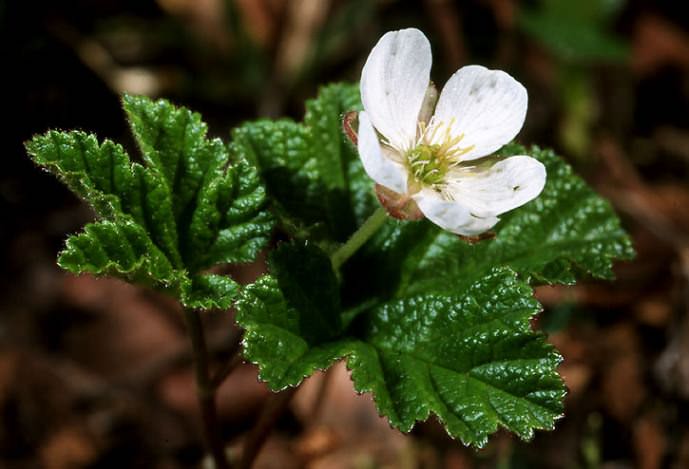

- Choosing an option such as seeds, you should be prepared for the fact that the properties of the plant may differ from the original, and not for the better. Sowing of seeds takes place in the autumn. In this case, planting is carried out immediately after collection, otherwise the germination rate will drop sharply. Seeds are placed in prepared soil or in boxes filled with substrate.
Purchased seeds are subject to stratification, which should be performed according to certain rules, which we have already talked about. The temperature should be between 3 and 7 degrees. The term is from 30 to 80 days. Planting takes place at a temperature of about 20 degrees in boxes filled with a mixture of sand and peat (1 to 4). In the spring, the plants are moved to a permanent place.
- You can purchase varietal imported bushes. But the question of whether the cloudberry will survive our winters remains open.
Secrets of use
In pre-revolutionary Russia, all kinds of dishes with cloudberries were regularly served at the tsar's table, and cloudberry kvass and liqueurs were always found in taverns and taverns. Now many recipes are forgotten, but in vain - after all, fragrant cloudberries are equally tasty both fresh and soaked and dried. And how much can you make from cloudberries! Jams, preserves, marshmallows, bright compotes, pies and cheesecakes ...
Fresh cloudberries are not stored for long - only two to three days, after which they begin to ferment. Therefore, in the very first days, the berries must be selected and processed. One of the simplest and oldest northern recipes is soaked cloudberries.
To prepare soaked cloudberries, you need a wooden tub and ripe, but not overripe berries. Prepare syrup in advance - about one glass of sugar per liter of water if you like sweet berries, or half a glass if you want sour cloudberries. Boil sugar syrup, then cool.
The container must be doused with boiling water and the orange fruits must be carefully poured into it. Fill the cloudberries with water, cover with a clean piece of cloth, on top - a wooden lid with a load. We put it in the cellar or underground, after 3-4 months the cloudberry is ready.
This berry can be used for compotes and jelly, prepare pie fillings or add to homemade yoghurts.
Beneficial features
The berry has a number of unique properties. The plant is a honey plant. Thanks to the substances that are part of the fruits and leaves, various diseases can be cured. So, the leaves are characterized by a hemostatic effect.
The berry contains:
- Phytostyrene
- Organic acids
- Fatty acid
- Tannins
- Plant sterols
- Cellulose
- Antioxidants and more
The berry not only looks appetizing in the photo, but also has wound healing, immunomodulatory, anti-febrile, tonic, astringent, antimicrobial properties. Reception of fruits has an antiscorbutic effect.
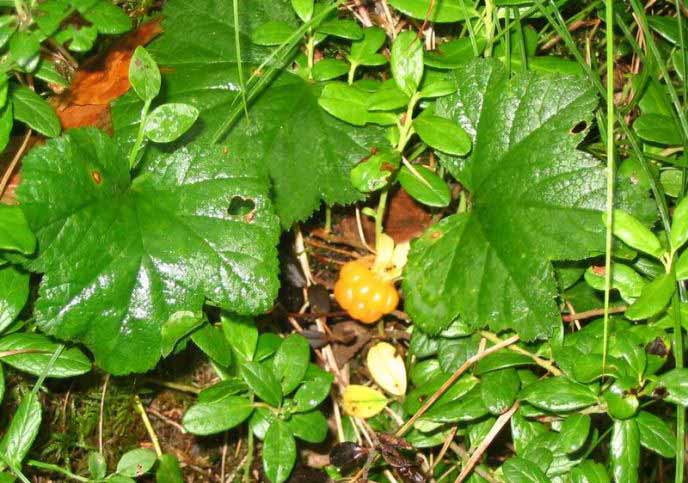

Useful properties of cloudberries
It should be noted that cloudberries are a storehouse of vitamins and minerals. That is why one can add to its unique taste the fact that cloudberries are a healing berry. Indeed, in folk medicine, "moss currant" is used in the fight against cardiovascular and gastrointestinal ailments.
It should be emphasized that cloudberry is an integral component of hygiene products and medical cosmetics. On the basis of cloudberries, liquid soap, toothpaste, shampoos, shower gels, foams and gels for washing are made. Vitamin C, which is part of cloudberries, improves the structure of hair and skin and relieves physical fatigue. Moss currant is also widely used in dietetics.
After listing all the beneficial properties of this amazing berry, surely every reader will wake up with a desire to learn about where cloudberries grow? Let's move on to looking at this issue.
Unfortunately, in the age of technological progress, few people show interest in this tasty berry: they simply forget about it, although in the Soviet era many loved to spend their leisure time collecting "moss currants".
But in the Scandinavian countries, many farmers are engaged in growing cloudberries, erecting barriers from wind and snow. Frosts are fatal for her. As a result, they get rich harvests of berries and sell them profitably in local markets.
A lot of cloudberries grow in the northern part of Russia, namely, on the Kola Peninsula and in Karelia. The berry predominates in wetlands, it is found in the shrub and moss tundra of the Far North. Locals love to make tinctures, preserves, fruit drinks from it. Where else does cloudberry grow? In a number of Russian regions: Pskov, Vologda, Novgorod, Leningrad regions.
A selection of the most-most places, as well as other interesting subtleties.
We will tell you about where to pick not only blueberries, but also lingonberries, cloudberries, blueberries and even cranberries (however, the latter will ripen only in September).
It is a cold-loving plant that prefers to grow in the northern natural zone. That is, it feels comfortable in places with severe winters and short summers. The only factors that cloudberries are sensitive to are sudden changes in temperature, as well as strong winds.
Today, the growth of this plant can be observed in the following countries: Finland, Sweden, Denmark, Scotland, England, Canada, some states of North America. It can also be found in Belarus, but in extremely small quantities.
In Russia
In Russia, unlike other countries, cloudberries can be found exclusively in forests or swamps. It is not grown under artificial conditions. To a significant extent, these shrubs grow in the following republics: Karelia, the Far East, Kamchatka, Komi, as well as in some areas of Arkhangelsk, Murmansk and Krasnoyarsk Territory.
This plant begins to bloom in mid-spring. But the fruits appear only in the middle of summer. When to pick cloudberries? It depends on the ripeness of the berries. Usually fully ripe fruits appear only in August.
How to pick cloudberries correctly? This is a pretty tricky business. For harvesting, you need to take into account the following points:
- First you need to know what a ripe berry looks like. At first, it has a deep green color, after which it turns red. When it has a rich yellow or orange hue, this indicates full ripeness of the berry. These are the fruits that should be picked.
- It is quite difficult to find shrubs. They grow mainly in swampy areas in thickets. Therefore, you can spend a lot of time looking for her.
- Cloudberries should not be picked in industrial or environmentally polluted areas. Berries and leaves absorb harmful substances. The consumption of such fruits can negatively affect health.
- Collecting cloudberry berries is best done in the morning or evening, in dry weather.
- It is better to pick berries together with sepals, which can also be used for medicinal purposes. Healing decoctions are prepared on the basis of dried leaves.
- Cloudberries spoil very quickly. Therefore, after collecting it, it is immediately required to eat or prepare various dishes. Also, many housewives freeze these berries for the winter.
Berries contribute to faster digestion of food, and also remove excess fluid and harmful substances from the body, which is important if you have extra pounds.
More useful and informative information about cloudberries:
- this plant is the closest relative of raspberries, therefore it is more advisable to call its fruits not berries, but polystyrene;
- cloudberry fruits are a storehouse of vitamins, they contain: C, E, A, PP, B1, B2;
- despite the fact that the plant grows mainly in the northern regions, it does not tolerate stable frosts;
- harvesting fruits is best done when they are in a semi-ripe state, so you can extend their storage time.
A variety of delicacies can be prepared from cloudberries, such as jelly, jam, jam, marshmallow, and more. During heat treatment, they lose a minimum amount of nutrients.
But in the Scandinavian countries, many farmers are engaged in growing cloudberries, erecting barriers from wind and snow. Frosts are fatal for her. As a result, they get rich harvests of berries and sell them profitably in local markets.
Herbaceous or semi-shrub plant up to 30 cm high with a creeping rhizome
Thin, erect, with two to three leaves and one apical flower
Same sex, single, white
Prefabricated drupe with a diameter of 1.5 cm, resembles raspberries in shape, but differs in its taste, sweet
Sometimes it is called “the opposite berry”: when ripe, it first turns red, and then becomes yellow-orange, amber. Cloudberry is a northern guest. It is found in peat bogs, in swampy forests, tundra, in the middle zone of the European part of Russia, Siberia, in the Far East, in Belarus.
The demand for cloudberry planting material is growing every year. And no wonder: delicious amber sweet and sour berries are a balanced source of vitamins, minerals and other nutrients that are essential for health. Cloudberries were once called "the royal berry", as they were valued for their weight in gold. 100 g of cloudberries contain 3 times more vitamin C than an orange.
Cloudberry is most common in Karelia, the Far East, Komi, as well as in the Arkhangelsk, Murmansk, Norilsk and Bryansk regions. That is, most often the berry can be found in the northern strip of the European part of Russia. But here we are dealing with a certain paradox: despite the active growth in northern latitudes, cloudberries are quite capricious.
Remember that the berry is not recommended for people with gastrointestinal diseases.
Cloudberry loves to settle in peat bogs or forest bogs, so it is not very easy to approach it. Often, it is adjacent to blueberries or lingonberries. The berry blooms in May-June and fully ripens in July. As a rule, they begin to harvest it at the beginning of ripening - the harvesting period is only 12-14 days.
You can store the berry either in its own juice or frozen. But keep in mind that fresh cloudberries will last no more than 1.5 months. You can freeze not only fruits, but also sepals - both those and those perfectly retain their medicinal properties.
Without a doubt, cloudberries are the most valuable berry, which is literally replete with useful properties. As you can see, due to the high content of vitamins, it is actively used for both prophylactic and therapeutic purposes. But do not forget about the contraindications for cloudberries, otherwise you risk falling into that small group of people for whom this berry is not the most useful.
Tasty and healing cloudberries are not accidentally recognized as a real treasure of the northern peoples - recipes from Arctic raspberries are still actively used in folk medicine.
Sun berries have a powerful hemostatic effect, as well as a diuretic and diaphoretic, which is especially important for colds. A decoction of ripe cloudberry fruits is recommended both for stomach upsets and as an aid for hypertension and vascular problems - the spectrum of action of the northern medicine is so wide.
But cloudberries are famous not only for fragrant berries - Wikipedia describes the various medicinal properties of the leaves and roots of the northern miracle berry. Infusion of cloudberry leaves treats severe diarrhea, metabolic disorders, cystitis and gout, a decoction of arctic raspberry roots will help with malaria, kidney disease, lingering colds.
What is useful berry
- When collecting berries, it is forbidden to use various mechanical devices (scoops, combs, etc.), which damage the thickets of berry stands and reduce the yield of berries in subsequent years.
- Harvested berries do not ripen after picking, so pick only ripe ones.
- Pick berries that you want to eat right away when the moon is growing, then they will be more fragrant.
- Collect berries for canning when the moon is waning, then they will last longer.
- Collect berries in cool hours (morning and evening) every other day, and in case of dry, hot weather, every day, avoiding overripening.
- The harvested berries should be immediately removed to a cool place protected from the sun, since those heated in the sun very quickly lose their appearance, taste and useful properties of berries.
- When carrying the berries, you should also cover from the sun.
In the photo it may seem that this is a small and very simple berry, but in fact it is a real storehouse of minerals, vitamins and other substances that are extremely valuable for human health.
How did cloudberry deserve the title of the main northern berry? Does it have contraindications and what are they connected with? Next, we talk about the most important features of cloudberries and where they grow in Russia and when they need to be harvested.
Cloudberries are a treasure trove of essential vitamins:
- C - in terms of the amount of ascorbic acid, the berry surpasses citrus fruits, for which it was nicknamed the "northern orange". Vitamin C not only helps to cope with colds, flu and other similar infections, but also strengthens the nerves and heart.
- A - retinol acetate supports the proper functioning of the thyroid gland.
Advice. Vitamin A has a positive effect on the development of the fetus, therefore cloudberries have long been considered indispensable during pregnancy.
- E - tocopherol is important for cell renewal and internal tissue repair.
- B1 - Thiamine is essential for the healthy functioning of the central nervous system and the brain.
- B2 - riboflavin is useful for the vision system: it protects the eyes from inflammation and even cataracts.
- PP - nicotinic acid helps to cleanse the body of toxic substances.
DETAILS: Cold pickling green tomatoes in a bucket
In addition, cloudberries contain unsaturated fatty acids, fiber, beta-carotene, pectin and important micro and macro elements:
- potassium;
- phosphorus;
- cobalt;
- iron.
Cloudberry contains a whole complex of vitamins and minerals
Also, one cannot fail to note the high content of a number of organic acids:
- apple;
- lemon;
- salicylic.
For health-improving purposes, not only cloudberries are traditionally used, but also its roots, sepals, and leaves. Why are they so useful?
- Cloudberry is a serious antioxidant, therefore it serves as a quality prevention of the development of cancer.
- Fruit juice has strong antibacterial and healing properties, therefore it is used to treat damaged skin and acne.
- Cloudberry helps to strengthen the immune system and free the body from harmful cholesterol.
- The berry normalizes metabolism, therefore it helps with obesity of varying degrees.
- Cloudberries serve as a good prevention against scurvy.
- Due to its diaphoretic properties and the ability to normalize body temperature, the berry is used for colds and fever.
- Sepals in the form of decoctions are useful for severe coughs and bronchitis.
- Cloudberry is able to restore the general strength of the body, therefore it is recommended for fatigue, weakness, poor appetite and even anemia.
Cloudberry improves human health
Separately, it is worth mentioning the benefits of berry extract - the components of cloudberry have moisturizing and tonic properties, therefore they are used in the manufacture of various cosmetics.
The oil with northern berry extract nourishes the skin, hair and nails.Rinses based on it strengthen hair, help restore its damaged structure, refresh curls, and also give them a natural shine.
In addition, cloudberry extract is often a component of various medicinal and anti-aging creams.
At first glance, it may seem that cloudberry is useful for everyone and is recommended for literal use for everyone, regardless of age and state of the body. But this is not always the case - although serious contraindications to the use of northern berries have not yet been identified, there is a group of people who are better off using cloudberries.
- Firstly, the berry contains a lot of organic acids, so it is not recommended for acute stomach diseases, ulcers, problems with the duodenum and chronic gastritis, which proceeds with complications - with active secretion of digestive juice.
- Secondly, cloudberry helps to lower blood pressure, so it is contraindicated for use in combination with medications for hypertension.
- Third, cloudberries are not recommended for severe kidney damage.
Overeating cloudberries can cause temporary allergic reactions.
Advice. If you have any doubts about the use of either the berry itself or preparations based on it, we recommend that you seek qualified advice from your doctor.
Since ancient times, cloudberries have been considered a source of vitamins, which is why they have always been used in folk medicine. It has always been considered a northern plant that grows mainly in the tundra. Where does cloudberry grow today? Let us dwell on this issue in more detail.
Description of the plant
Cloudberry is a small shrub - about 30 cm tall. Stems are slender, erect, with a single apical flower. Flowering begins in spring. The first fruits can be seen in the middle of summer. They are berries that resemble raspberries in appearance. Only the color differs, it is yellow in cloudberry fruits. What a cloudberry berry looks like can be seen in the photo.
Beneficial features
Why are cloudberries useful? The main advantage of the berry is the presence in its composition of a large amount of vitamins, organic acids, phytoncides and other useful substances. The use of these berries has the following effect on the human body:
- improves the functioning of the gastrointestinal tract;
- destroys germs, viruses and bacteria;
- helps to strengthen the immune system;
- helps to restore strength after illnesses;
- removes harmful substances from the body;
- normalizes blood cholesterol levels;
- improves the work of the cardiovascular system;
- used to treat cough;
- lowers blood pressure in hypertensive patients;
- prevents edema due to its diuretic effect.
Interesting! Also, modern scientists, as a result of their studies, have found that cloudberry helps prevent the development of malignant tumors.
Therefore, it can be used as a prophylaxis against cancer.
Where does the berry grow
Today, the growth of this plant can be observed in the following countries: Finland, Sweden, Denmark, Scotland, England, Canada, some states of North America. It can also be found in Belarus, but in extremely small quantities.
In Russia
Where the berry grows, the natural conditions are very harsh. It is found even in the Arctic Circle. In Russia, it grows in the north of Siberia and in the north of the Far East. Cloudberry is common in Scandinavian countries such as Sweden, Norway. She is in England and Alaska.
In Finland, coins are minted with the image of this berry. Cloudberry has perfectly adapted to the conditions of the tundra and forest-tundra. It grows in wet, swampy, mountainous areas, plains and mounds.
It grows, forming a dense carpet, at the top of which, you can see translucent amber berries.
The plant is very productive, up to 1,000 kg of berries are harvested from one hectare.
In Russia
How and where does cloudberry grow. Uloma swamps.
Cloudberry is a delicious orange-amber berry, known for its rich set of useful properties for a long time. In the photo it may seem that this is a small and very simple berry, but in fact it is a real storehouse of minerals, vitamins and other substances that are extremely valuable for human health.
Where the berry grows, the natural conditions are very harsh. It is found even in the Arctic Circle. In Russia, it grows in the north of Siberia and in the north of the Far East. Cloudberry is common in Scandinavian countries such as Sweden, Norway. She is in England, and in Alaska. In Finland, coins are minted with the image of this berry.
It contains vitamins of group A, B, C, E and PP and organic acids:
- lemon
- salicylic
- apple
From mineral substances;
- silicon
- iron
- phosphorus
- potassium
- aluminum
- magnesium
- calcium
It contains pectin and tannins, vitamin A carotenoids, dietary fiber, sugar, fiber and water.
Cloudberry is a herb that loves wet places. Distributed in northern latitudes, tundra and forest-tundra. In the forest, this berry grows in the same area as cranberry - in swamps, near rivers. It should be humid nearby, as the plant loves this climate. In addition, the northern berry tries to grow in the shade, since the sun does not spoil the berry too much in its native land.
This is a non-single plant, it grows immediately with a carpet. Therefore, it is convenient to collect it not only by hand, but also with a combine.
The natural habitat of cloudberries is the tundra. It is a cold-loving plant that is comfortable to grow in regions with long winters and very short summers. Feels great in the northern regions of the forest-tundra. Does not tolerate strong winds and torrential rains. And also the temperature difference is destructive for her. The crop tolerates frost better than sudden temperature fluctuations.
The plant prefers soils with high humidity, waterlogged. And this beauty also grows in mountainous areas, on plains and mounds.
Tver region
Of course, many are interested in the question of whether cloudberries are found in Moscow? No, the berry does not grow in the Russian capital. But Muscovites, if they wish, can go to a neighboring region, namely to the Tver region and pick up "moss currants" in a swampy area, not far from the town of Vyshny Volochek.
This is another iconic place where cloudberries grow. Sixteen kilometers from Vyshny Volochok is Lake Metz, in the marshy surroundings of which you can also pick delicious berries.
Not everyone knows about where cloudberries grow in the Leningrad Region? It's no secret that this region is rich in marshlands, so there are more than enough of the above berries in it. In many areas where there are marshes, you can pick berries. Where does cloudberry grow in the Leningrad region?
Or maybe cloudberries grow in Syktyvkar? Not in the city itself, but the inhabitants of the Komi Republic pick berries in the Pychimsky swamp, which is located next to a place with the unusual name of Kochchoyag. The gas pipeline runs through the swampy area and the collection point can be reached by car, since there is a dirt road.
Also, the Kortkeros region of the republic is rich in "moss currants". One of the glades is located along the road to the village of Madzha.
On the right side of the Kortkeros - Veselovka road section, starting from the 9th kilometer, there are also cloudberry plantations. This territory was nicknamed Sobinovskie swamps. They are far from the track and occupy vast territories, so it will be difficult for an inexperienced berry-grower without a compass to navigate in them.
Experienced cloudberry gatherers say that when you come to the swamp, the berries are visible to the naked eye, and in good years they simply cannot be counted. For many, the collection of "moss currants" is one of the ways to earn money, and the berry ends up not only on domestic, but also on foreign markets.
Top 10 Busting Stars It turns out that sometimes even the loudest fame ends in failure, as is the case with these celebrities.
Surprisingly: Husbands want their wives to do these 17 things more often. If you want your relationship to be happier, you should do the things on this simple list more often.
These 10 little things a man always notices in a woman Do you think your man knows nothing about female psychology? This is not true. Not a single trifle will hide from the gaze of your partner who loves you. And here are 10 things.
Why do you need a tiny pocket on jeans? Everyone knows that there is a tiny pocket on jeans, but few have thought about why it might be needed. It is interesting that originally it was a place for the Chr.
10 adorable star children who look completely different today Time flies, and one day little celebrities become adults who are no longer recognizable. Pretty boys and girls turn into s.
9 celebrity women who fell in love with women It is not unusual to show interest in someone other than the opposite sex. You are unlikely to be able to surprise or shock someone if you admit it.
Today, very few people remember about such a berry as cloudberry. But still relatively recently, this berry bore the proud title of "royal". And it is not at all coincidental, because behind its more than modest shell is hidden a real treasury of vitamins. For example, cloudberries simply have no equal in terms of vitamin C.
Since olden times, cloudberries were taken on long hikes by hunters - hunters and navigators, for whom this berry served as a reliable protection against scurvy. Decoctions from its leaves have found wide application in northern folk medicine: they treat heart and stomach diseases, are used for the fastest scarring of wounds and as an antipyretic agent. To find out where the wonderful cloudberry grows, we suggest going on a short trip.
DETAILS: The best potato varieties Belarus
Where does cloudberry grow?
Although the shape of the leaves prompted scientists to think that cloudberry was originally a southern inhabitant, it only grows in the north. This plant successfully survives in severe winters and short, cool summers. The only thing she doesn't like is sudden temperature changes and strong gusts of wind.
Unlike the Scandinavian countries, where cloudberry cultivation is on stream and takes place on special farms, in Russia this berry can be found only in the wild. It grows in large quantities in swamps and swampy forests of the Republic of Komi, Karelia, the Far East, Kamchatka, the southern regions of the Krasnoyarsk Territory, the Murmansk and Arkhangelsk regions.
Interesting Cloudberry Facts:
- Cloudberry is the closest relative of raspberry. Strictly speaking, its fruits (like those of raspberries) are incorrectly called berries - these are polystyans.
- The fruits of cloudberries contain most of the vital vitamins: C, A, E, B1, B2, PP.
- Although cloudberries live in the northern regions, they do not tolerate frosts and other vagaries of the northern climate.
- When ripe, cloudberries change color, first from green to red, and then to yellow.
- Cloudberries can be stored for over six months without sugar or freezing.
- It is necessary to collect cloudberries in a semi-ripe state, since when fully ripe, it chokes easily.
More recently, cloudberries grew exclusively in the wild. But gradually the culture began to settle down and the plots of amateur gardeners.
When cloudberries ripen
The northern berries ripen in July. At this time, a raspberry-like fruit is formed.It is a drupe, which consists of several bones, each of which contains a rather large bone inside. Cloudberry is a close relative of raspberry, but its color is easy to mistake.
Attention! If the berry is red, then it is an unripe cloudberry.
During full maturity, when the berry contains the maximum amount of vitamins and nutrients, the northern beauty has a bright yellow color. If you collect red fruits, then they must be ripened.
How to get to your destination?
How to get to the place? First by train to Tver, and then to Terelesovskaya station. The rest of the path will have to be done on foot: through the village we go into the forest, and then along the swamps to the lake. On the way, you may not meet cloudberries in the forest, but you can pick up plenty of blueberries and mushrooms.
You can also go for the "moss currant" by car. You need to get to Vyshny Volochok, from there to the village of Berezka, where you can rent a motor boat that will take you to your destination.
There is another travel option: not far from the village of Berezka, there is a recreation center where you can rent a room and stop the car. Here you can also collect a kayak (you should worry about this in advance) and go to the lake on your own.
There are a lot of cloudberries on the banks of Metz in its wider part. Since it is far from the villages, there are not many people there, and cloudberries are called a dime a dozen. On the opposite bank from the village of Berezka, you can pitch a tent: it is better to take a boat or a kayak with you, so that you have the opportunity to look for “fruitful” meadows while swimming from coast to coast.
How to get to the place? First by train to Tver, and then to Terelesovskaya station. The rest of the path will have to be done on foot: through the village we go into the forest, and then along the swamps to the lake. On the way, you may not meet cloudberries in the forest, but you can pick up plenty of blueberries and mushrooms.
There are a lot of cloudberries on the banks of Metz in its wider part. Since it is far from the villages, there are not many people there, and cloudberries are called a dime a dozen. On the opposite bank from the village of Berezka, you can pitch a tent: it is better to take a boat or kayak with you, so that you can, while swimming from coast to coast, look for “fruitful 9raquo; glades.
How to pick cloudberries correctly
At first glance, manual assembly is not difficult. But this must be done correctly in order to preserve the integrity of the collected material:
- The berry is harvested with sepals.
- Ideal with a reddish tint.
- It is necessary to put the collected in low containers so that the berry does not choke and spoil during transportation.
Hand picking has one major advantage - you can pick berries at the desired ripeness stage and size. But there is also one major drawback - a big waste of time.
How to quickly collect cloudberries
For those who do not have time to pick cloudberries by hand, using a berry harvester is perfect. Such a device will help you quickly and without damage to collect a large number of berries. At the same time, there are several types of combine, which differ in the level of mechanization and device. Harvesters for picking berries are:
- Manual, without mechanization of the process. A container with a special device that resembles a rake.
- Manual mechanisms with mechanization of the process. These are products that are held in the hand, but at the same time have a mechanism like a motor for translational movements.
- An automatic device controlled by the operator. This is a huge harvester that looks like a simple combine harvester. The only difference is in operational management. It is used for collecting cloudberries on an industrial scale.
Smaller harvesters are used for home harvesting, while larger, complex machines are used for industrial harvesting.
Syktyvkar
Mushrooms of the Leningrad Region
Red mushrooms
Aspen mushrooms are found in the Gatchina region. For example, the village of Druzhnye Gorki, where the pine forest has its own "red glades". One problem: real abundance, as the old-timers say, comes every 5 years - the last time was in 2009. But you can go there and check.
Black milk mushrooms
Sinyavinsky swamps, the valley of the Chernaya river. The forest here is complex, because it is dense and the soil is swampy. A variety of mushrooms grow. For example, Lake Khondrova has birch edges with beds of black mushrooms. On the other side of the field, closer to the Murmansk highway, closer to the peat mines, there is a deciduous forest in which white, aspen, and chanterelles grow.
Good milk mushrooms grow near the village of Nadino in the Tosno region.
Porcini mushrooms are found in the pine forests. For collectors, the only danger is to accidentally wander into the border zone. Also, good boletus are found near Shapok in the Kirov region.
Good forests in the Vyborg direction. Some praise Zakhodskoye, others - the area around Lake Zerkalny, but now, perhaps, it is overpopulated. The best mushrooms, according to popular rumor, grow on the territory of the former Finnish airfield, although the forest there is young. Since it was planted on purpose, pines grow there in beds, and it is a pleasure to walk.
“In a dry summer, it rolls like a ball, but if it fires after the rains… it’s beyond words,” say mushroom pickers from Vyborg. - In those days, when there were closed army training grounds, that is, there were no strangers around, and all the mushrooms went to 2-3 local daredevils, the amount collected per day was measured only by the capabilities of a living healthy person.
It began in 1985, when our army began to be reduced, and lasted for about 10 years. Then and now a diesel train went to those regions, but nothing else. Twice a day. It was incredibly difficult to get into it with baskets, but the pleasure overcame everything. Now, in the era of general forest debris and general motorization, the average indicator is about a hundred boletus. Per day. It seems to be a lot, but before it was an hour's rate ”.
From Zakhodskoye to St. Petersburg there are “mushroom” electric trains: every second passenger travels with a basket.
Well, the best places in this direction start after the border with Finland. The Finns do not pick mushrooms themselves, but they allow tourists.
Boletus
Champion in boletus - Kirovsky district, for example, the vicinity of Matoksa. Collecting 100 mushrooms in a few hours is a common thing.
The Priozersk region could be called a mushroom mecca - there are the densest and cleanest forests there. Now, due to road repairs, it is difficult to get there, but those who have overcome all the difficulties will receive a reward. On a weekday near Steklyannoye, when you turn from Priozerskoye highway to concrete road, you can collect 5 white buckets.
Mushroom pickers tips
“Milk mushrooms grow on the Borisovskaya jumper. White - near the Bolshoy and Maly Shchuchye lakes. Aspen mushrooms - near the river Gladysh, - said Igor Kustov from the Sosnovsky mushroom picker. - Good whites grow near the village of Zaporozhskoe, this is already near Ladoga. And the mushroom place closest to Petersburg is Agalatovo. This is also the Vsevolozhsk region.
We add that cautious Petersburgers do not like mushrooms collected near Kolpino and other industrial areas. That is, for themselves, maybe they collect it, but it is difficult to sell them.
In general, concrete is such a mushroom belt. Both in Kirovsky and Priozersky districts, mushroom pickers-motorists leave their cars there. They leave for the forest and return in 3 hours with full baskets.
The districts of the Leningrad Region, especially those that can only be reached by water transport, for example, Verkhniye Mandrogi in the Podporozhsky District, are no less mushroom places than the nearby suburbs. Other eastern regions - Lodeynopolsky and Boksitogorsky - are more suitable for hunters.
Galina Fedulova, experienced mushroom picker: “There have been a lot of mushrooms for the last 3 years.Even in arid 2010: at first it was bare in the forests, but in September it rained and mushrooms were coming out of the ground right before our eyes. The mushroom season traditionally begins with deciduous forests, and they, as more thermophilic, are located in the south.
Berries of the Leningrad region
In the Leningrad region, blueberries grow best: they can be picked almost everywhere, but it is best obtained in the Vyborg region. With a certain skill, a liter can is assembled in an hour.
Cranberries grow in swamps: berry-growers praise the swamp in Sosnovo, Michurinsky, and the village of Molodezhnoye. The closest to St. Petersburg are the Kharvyazi bog to the west of the Chernaya Rechka-Elizavetinka road, and the Lembolovskoye bog. There are cranberry swamps in the direction of Tosno, in the Lakhta-Gumbaritsa region.
DETAILS: How to harvest cucumber seeds at home?
The most famous is the Mshinskoe swamp in the Luga region. This is where you can get hold of both cloudberries and cranberries. The same can be said about the Glebovskoe swamp (Gatchinsky, Luga and Tosno districts), but Mshinskoe is still better. Please note that berry swamps can also be nature reserves at the same time, where it is allowed to walk, but you cannot pick off the bushes.
The real kingdom of cloudberries is Karelia, respectively, most berries are in the adjacent Podporozhsky region. But in Priozersk, although the region is northern, there are few cloudberries. There is no suitable swamp.
Blueberries are very popular with berry growers because they are easy to pick while standing. In some places of the Leningrad region there are artificial plantations, but it is better not to meddle there, since this berry has its own owners. There is a nature reserve between the villages of Lopukhinka and Gostilitsy, where blueberries grow on their own. But this is for those who are not afraid of gamekeepers.
As for the strawberries, they do not grow too vigorously, and the collected ones are usually suitable for decorating a cake, and not for jam. Experienced berry growers say that you can collect a liter or two in the forests near Gatchina, for example, in Taitsy and Kommunar, as well as in Sinyavino and Malux.
Is it possible to collect unripe cloudberries
Unripe cloudberries will ripen quickly at home. In this case, the berry will have more opportunities to remain intact. If picked too ripe, it cannot be stored for a long time, and it will be difficult to process the berry. The main thing is to be able to ripen it correctly.
How to ripen cloudberries
There are several ways to ripen cloudberries at home:
- Place in an even layer on a paper towel. It is enough to hold the berry for 2–4 days.
- Place in a cool place with sepals.
Before putting on ripening at home, it is imperative to sort out the berries, and then rinse and dry. If you collect ripe fruits, then she may simply not live up to the house. In a cool place, cloudberries become fully mature in 3 days.
First of all, from unripe fruits it turns out to harvest dried berries. It is simple to dry the northern royal year for the winter: it is necessary to spread it out on pallets in an even layer and put it in a well-ventilated room without access to direct sun.
An excellent option for harvesting an unripe specimen is a pickled berry:
- Go through and pour into the jar.
- Pour boiled water at room temperature.
- For three liters of water, you can add half a glass of sugar if you wish.
- Cover the jar with gauze and put in a cool place.
In this form, it can be stored from six months to two years. At the same time, the degree of maturity does not matter. Ripening of cloudberries for such harvesting is optional.
- Blueberry
They say there are a lot of blueberries this year. This is the most common forest berry in the Leningrad region.
- Station Zakhodskoye of the Vyborg railway line
If you go by rail in the direction of Vyborg, you need to get off at the next station after Kannelyarvi. Walk 3.5 kilometers to Bolshoy Krasnoperskoye Lake, the shores of which are densely covered with blueberries. Nearby there are pine forests where blueberries love to grow. Walking around the lake, you can easily collect a basket of berries.In addition, the lake is clean, with a sandy bottom, which is so pleasant to swim in.
- Yappilya stopping point
This inconspicuous stop, to which only diesel goes three times a day, is located on the railway track to Vyborg via Primorsk in the Finland direction. You need to know the exact schedule of diesel engines - they run very rarely (three times a day), you can find out at the station, be sure to pay attention to changes in the schedule.
There are also a lot of blueberries in the following places: near the village of Sverdlova (from the metro station "Lomonosovskaya", minibus K476, bus 476 to the stop. "Settlement named after Sverdlov"), near Vyritsa blueberries stretch to the river Oredezh (you can get there by train from the Vitebsk railway station), the shores of the Cheryomukhovoye Lake near the recreation center "Dream" (travel from Ladozhsky railway station to p.
Budogosh), in the area of the old Chudovskaya road (Moscow direction) on both sides. At worst, you can just drive to Zelenogorsk and go deeper into the forest in search of the cherished berry. Of course, near Zelenogorsk, the forests are not so deaf, and there are fewer blueberries (and there are more people, respectively), but you can still find something.
- Station Zakhodskoye of the Vyborg railway line
This inconspicuous stop, to which only diesel goes three times a day, is located on the railway track to Vyborg via Primorsk in the Finland direction. You need to know the exact schedule of diesel engines - they run very rarely (three times a day), you can find out at the station, be sure to pay attention to changes in the schedule.
When to collect cloudberry leaves
The leaves are used to prepare various decoctions and are harvested in several ways. But before harvesting, they must be properly assembled. Leaves should be picked at the moment the bud is forming and the flowering period begins. At this moment, the leaves contain the greatest amount of nutrients.
It is optimal to collect the leaves of the lower and middle of the stem. It will be useful for a plant if the number of collected leaves from one bush does not exceed a third of its total volume of leaves. Otherwise, the plant will be sick and will not be able to bear fruit normally next year.
Conclusion
Northern berry contains a huge amount of nutrients and a whole range of vitamins. But in order for it to be useful, it is important to collect it correctly and be able to prepare it. Unripe berries are stored better, since ripe cloudberries quickly become juice and their integrity is compromised during transportation.
Ripening cloudberries at home is a process that takes a couple of days. As a result, a storehouse of vitamins can be frozen, dried, made jam or jam. If you do not want to collect fruits by hand and spend a huge amount of time, you just need to use a harvester, which you can make yourself or buy in a store. The harvest period is July, 1.5 months after flowering.
Where cloudberries grow, all residents of the Northern regions of Russia and other countries know. But to collect it, you need to find a suitable swamp, as well as places where the berries grow in a solid carpet. For those who know little about what this storehouse of vitamins looks like, it is recommended to look at a photo of cloudberries on the Internet.
- Blueberries
Blueberries grow taller than blueberries, and it is more convenient to pick them - no need to crawl on all fours. True, it is not recommended to eat a lot of blueberries at a time - you may feel dizzy, there will be intoxication as from a couple of glasses of wine. There is a nature reserve between the villages of Lopukhinka and Gostilitsy, but there, picking "drunken berries", you can run into the gamekeepers.
Blueberries have many names - olubika, vodka, cabbage roll, dove, gonobob, gonoboe, gonobol, fool, fool, fool, fool, drunk berry, drunkard, drunkard, drunkard, blue grapes, titmouse. The berry has a mild taste, so it is mixed with blueberries, lingonberries. It is actively used for making wine.
Contraindications to the use of cloudberries
Although cloudberry fruits have many beneficial properties, in certain cases they can be harmful to health. Diseases for which they should not be used are:
- low blood pressure;
- increased acidity of gastric juice;
- a stomach or duodenal ulcer;
- gastritis during an exacerbation;
- individual intolerance or hypersensitivity to berries.
Also, people with diabetes should not eat foods based on cloudberry fruits. This is due to the fact that sugar is used in their preparation. Because the berries have a sour taste.
In other cases, cloudberry has a beneficial effect on the human body, strengthening its immune system.
Despite all the wonderful properties of the berries of the north, cloudberries have a number of contraindications.
The main rule is to make sure that you are not allergic to arctic raspberries before using. Do not get carried away with cloudberries in case of gastric ulcer and diseases of the duodenum, and in case of enterocolitis, amber berry is strictly prohibited.
Experts also do not recommend eating large quantities of cloudberry seeds - they are very irritating to the stomach, so if possible, try to just spit them out.
In pre-revolutionary Russia, all kinds of dishes with cloudberries were regularly served at the tsar's table, and cloudberry kvass and liqueurs were always found in taverns and taverns. Now many recipes are forgotten, but in vain - after all, fragrant cloudberries are equally tasty both fresh and soaked and dried. And how much can you make from cloudberries! Jams, preserves, marshmallows, bright compotes, pies and cheesecakes ...
Fresh cloudberries are not stored for long - only two to three days, after which they begin to ferment. Therefore, in the very first days, the berries must be selected and processed. One of the simplest and oldest northern recipes is soaked cloudberries.
To prepare soaked cloudberries, you need a wooden tub and ripe, but not overripe berries. Prepare syrup in advance - about one glass of sugar per liter of water if you like sweet berries, or half a glass if you want sour cloudberries. Boil sugar syrup, then cool.
The container must be doused with boiling water and the orange fruits must be carefully poured into it. Fill the cloudberries with water, cover with a clean piece of cloth, on top - a wooden lid with a load. We put it in the cellar or underground, after 3-4 months the cloudberry is ready.
This berry can be used for compotes and jelly, prepare pie fillings or add to homemade yoghurts.
Despite the undoubted benefits for the body, cloudberries can also bring harm to the body. It has some contraindications for its use. First of all, you need to make sure that there are no allergies that cloudberries can cause. If you are allergic to raspberries, it is possible that they are also allergic to cloudberries.
The northern berry has found its application in many areas. It is used in folk medicine, industrial cosmetology and cooking. You can make jam, jelly, compotes from it and just freeze it to get healthy vitamins in winter. Its benefits are enormous. No wonder one of its names is "royal berry".
- Plum for the Leningrad region the best varieties
- Mushrooms in Samara and the Samara region (47 photos): where edible, mushroom places, mushroom pickers grow
- Mushroom places in the Rostov region, where mushrooms grow in the Rostov region, where to pick mushrooms in the Rostov region.
- Where to collect honey mushrooms in the Leningrad region: photo, where mushrooms grow in the Leningrad region
Contraindications
There are no particular contraindications for cloudberries. You should not use it for individual intolerance, as well as for gastritis with high acidity, stomach and duodenal ulcers.
Recipes
- Leaf tincture: two teaspoons of crushed dry leaves are poured into a quarter liter of boiling water. Insist for four hours, after which the drink can be consumed.It is taken for kidney stones, gout, metabolic disorders. Regular consumption improves the condition of gastritis with low acidity.
- Tea with cloudberries: for one part of cloudberry leaves, take two parts of dry rose hips. The mixture is poured with boiling water, insisted for one hour and consumed instead of tea. Despite the harmlessness of the composition, drinking more than two glasses a day is not worth it. This drink strengthens the immune system, which is especially important in the season of colds and viral diseases, helps with cystitis as part of complex therapy.
- Infusion of flowers: one tablespoon of dried cloudberry flowers is poured with half a liter of boiling water. Insist an hour and filter. Take half a glass four times a day, one hundred milliliters.
- Broth: chopped dry roots and cloudberry leaves are mixed in equal proportions. Take a tablespoon of such a mixture, pour in a quarter of a liter of cold water and put on fire. After boiling, cook with low heat for fifteen minutes. Then remove and leave to infuse. After forty minutes, filter the broth and bring the volume to the original two hundred and fifty milliliters (add boiled water). The finished broth is taken in fifty milliliters half an hour before meals.
Cloudberry useful properties (video)
The presented plant is appreciated all over the world due to its unique healing properties. You can grow it on your site, but for this you have to properly prepare the soil and take care of it every day.

